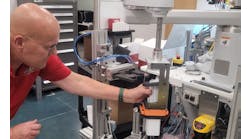Read the full Workforce Week series
Given recent advances in data acquisition and analytics, some users and developers are investigating whether better, closer-at-hand information can patch some of the know-how and experience gaps created as veterans are replaced by rookies.
"It's always hard to find new people to fill the shoes of those with institutional knowledge. This lack hasn't changed, but the Plan B these days is taking that knowledge and building more of it into controls, and using it and human capital to make operations more efficient," says John Tertin, sales and marketing director at ESE Inc., a Control System Integrators Association (CSIA)-certified system integrator in Marshfield, Wis. "Even veterans did many procedures they didn't have to back when controls were more manual. Now, we have automated data and IIoT, and they're letting us do integration projects that we couldn't do before, such as inter-company compliance between plants.
"For example, we worked with a natural cheese-maker that uses a very precise process that relies on institutional knowledge and written data, and were able to implement a paperless batch reporting system that gave its operators a lot more time in their day. We also worked with a salad dressing, ketchup and sauce manufacturer with many formulas that needed to integrate its inventory transactions with SAP software, and manage its MES layer and controls down to its pumps and valves. Both manufacturers use the same ControlLogix controls between their tanks and fillers, and we added ESE's flexible batch engine that combines PLCs and HMI screens developed with Rockwell Automation software, but we also integrated much of their institutional knowledge into their new batch sequences, including issues their experts would look for and procedures they'd perform for the best results."
Tertin reports ESE's batch solution includes enough best practices that today's operators don't have to be as expert as those in the past. "This can help a user's workforce at all levels. However, when we train onsite near the end of commissioning, it's all onscreen and functions just as millennials would expect, so the veterans can be more impacted than the newbies," explains Tertin. "We try to have clients understand that automation means operators don't have collect data manually or push as many buttons, but they still have to turn on their controllers to run more efficiently. In this case, one operator that used to run four systems can now run six. Unfortunately, automation still has to deal with the stigma that it causes jobs to be lost, which isn't true. Automation enables organizations to utilize their staffs in more value-added ways, such as optimizing production, responding faster to recalls or other incidents, and becoming advisors to more artisan-style processes, instead of frantically running around as they did in the past. Plus, digitalizing formerly written data means it's more accessible, so users aren't flying blind because they can easily see it on screens or upcoming augmented reality (AR) interfaces."
To further support its clients, Tertin adds that ESE also recently developed a support gateway edge device, which includes a Microsoft Windows server and VMware hypervisor, which distributes SCADA systems such as Rockwell Automation's FactoryTalk View SE to users via thin-client interfaces. "This lets us know if the PLCs and servers are running, and enables remote monitoring SCADA via two Ethernet adapters or a cellular modem, which can take data to a cloud service or send discrete event via email," adds Tertin. "These functions can help thinly spread staffs, and frees them do more useful tasks instead of just sitting in front of a screen waiting for red lights."
Sam Hoff, CEO of Patti Engineering, a CSIA-certified system integrator in Auburn Hills, Mich., adds: "We just worked with a client who has 200 manufacturing engineers, and 100 of them are eligible to retire in the next five years, so a lot of expertise is going to walk out the door. These guys have worked 70-80 hours per week to keep the processes running. They have also sacrificed a lot of home time putting in these hours. The younger generation generally will not work long hours in the facility. They don't mind getting on their smart phones, so we have to find ways for them to support their applications without being tied to them all the time."
In these data-rich environments, Hoff reports that users expect to do data analytics onsite, which can be a mistake. Patti helps with equipment analytics aided by artificial intelligence (AI), checks systems daily, and issues reports weekly. "I'm a baseball fan, so I know that pitcher Justin Verlander improved a lot after he was traded from the Detroit Tigers to the Houston Astros, and he said it was because of the analytics that the Astros gave him. In the same way, we ask how we can take data from existing processes and look at it in new ways based on problems we're trying to solve. For example, we can gauge wear on a cutting tool by monitoring and tracking current draw on the spindle. When the spindle starts drawing more current, we know the tool is probably getting dull. Previously, we'd monitor for fault over-currents, but not usually cycle-to-cycle. Putting data in the cloud means we can do more analytics with the data and help the person on the floor work smarter by helping him analyze his equipment through data.”
Despite recent staffing losses and technical upheaval, Kevin Ross, account manager at Experitec, distributor and Impact Partner of Emerson Automation Solutions, agrees that workforces can be stabilized by using process control carefully. "They're not mature yet, but many apps are emerging for simple automation solutions, such as handling the electronics on pneumatic valves, instead of doing it manually," says Ross. "Field instruments are also getting intelligence and AI layers that can provide better alerts, focus on underlying problems, and find trends going in the wrong direction, but they all depend on users knowing what problem they want to solve.
"For instance, DeltaV DCS added advanced process control (APC) software to improve tuning, while DeltaV Mobile displays on a smart phone app. Tools like these can make a big difference for applications that used to be mostly manual, relying on people to turn valves, and suffering burned out motors when they made mistakes. DeltaV Mobile can also help personnel spread out between small, remote terminals, which struggle to find people at the best of times, but still need to run 24/7 and have continuous monitoring to avoid overfills. However, these solutions can't help until users find them, which is why it's important to get out to users groups and industry events. We should also be open to trying new and potentially better methods, but we can't do everything at once, so we also have to decide which will be the most useful and deliver the best return on investment (ROI)."
Learn to program
To make the most of all the data their applications generate, it's becoming increasingly clear that process engineers are going to have to learn to write code and computer programs. Kurt Braun, senior sales and applications engineer and IIoT market specialist at Wago, agrees hiring new talent can't be the only way to fill skill gaps, so existing personnel must gain new, software-based abilities for their organizations to compete.
"When we're integrating IIoT, we also have to talk about cybersecurity, but many skills are lacking like Linux programming that lets IIoT applications grow up," says Braun. "Older controls on virtual private networks (VPN) could also be a security nightmare and risky due to open ports, but many of the these tools are getting easier, such as cloud-computing systems using MQTT with SSL/TLS encryption to bring in data from sensors and instruments in small JavaScript Object Notation (JSON) payloads that each device can publish or subscribe to."
Braun reports two new services for connecting to devices, gathering their data, and publishing it this include Amazon Web Services (AWS) IoT Greengrass and Microsoft Azure IoT Edge.
"Communities of edge devices can talk to each other as an extension of cloud services. This means an IIoT edge gateway such as a Wago controller can negotiate traffic from a process application to a network, and let local devices talk to the cloud via an edge gateway that can be onboard, and manage users' software keys for SSL/TLS encryption. This is where Linux can be helpful because, while simple applications can still use Ladder logic, aggregating data from hundreds of applications like well sites to the cloud needs an edge device and MQTT instead of previous PLC and DCS programming that are complex and costly. This is why users need to learn about IIoT and the cloud."
Braun adds Wago helps users develop these skills by offering webinars and in-person seminars about products and personal development topics, such as IIoT, cybersecurity and cloud computing. "More questions about these new technologies are coming up all the time, so even recent graduates might not know the answers," explains Braun. "Users can leverage vendors to learn, but there's a lot of information out there, including my personal YouTube channel that has 115 tutorial videos, more than 10,000 subscribers, and more than 2.5 million views. It has videos on controls and PLCs, but also on the cloud, IIoT and how I/O products can work with Raspberry Pi. It also features our PFC200 that's a like a Raspberry Pi because it runs on Linux OS and an ARM microprocessor, but can tie to real-world I/O such as our 750 Series that has a Modbus interface, and recently added support for Cirrus Link's Sparkplug protocol."
Braun adds three online resources for learning to program are:
- Codeacademy that offers free, interactive coding classes in 12 different programming languages, such as JavaScript and Python for JSON;
- Scotch.io that offers courses, training, tutorials and a blog about coding and fun, practical web development; and
- Node-RED flow-based development and visual programming tool for wiring hardware, APIs and online services for IoT applications. It also uses JavaScript, and has browser-based flow editor for creating JavaScript functions.
"Because developing new skills means learning by doing, users and organizations should start skunk works to help acquire the new capabilities they need," adds Braun. "For example, employees at Google can spend 20% of their time working on their own projects, if they can show it will add value to be company. On the other hand, we see many system integrators just redoing what they've previously done, which sells themselves short on capabilities they could add."







